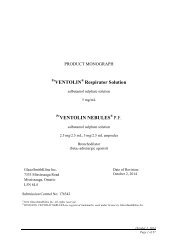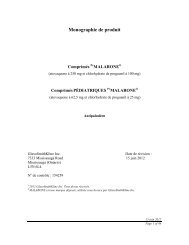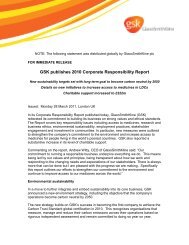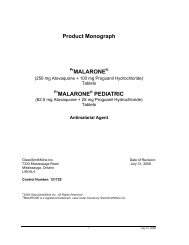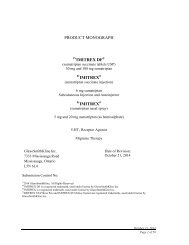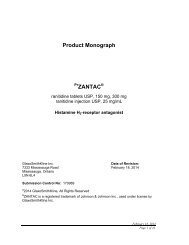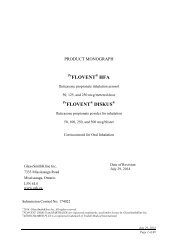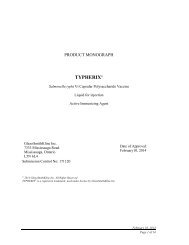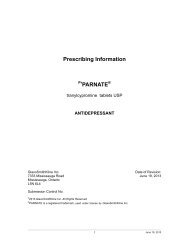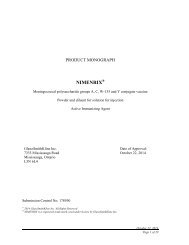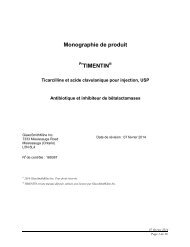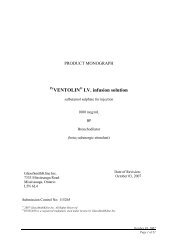ADVAIR DISKUS ADVAIR - GlaxoSmithKline
ADVAIR DISKUS ADVAIR - GlaxoSmithKline
ADVAIR DISKUS ADVAIR - GlaxoSmithKline
You also want an ePaper? Increase the reach of your titles
YUMPU automatically turns print PDFs into web optimized ePapers that Google loves.
<strong>ADVAIR</strong> ® / <strong>ADVAIR</strong> ® <strong>DISKUS</strong> ® are combination products of salmeterol and fluticasone<br />
propionate. However, since the SMART study did not assess the inhaled corticosteroid<br />
(ICS) dosages actually used by the patients, and may be different from those in the<br />
<strong>ADVAIR</strong> ® combination products, it cannot be concluded that the increased risks<br />
observed with SEREVENT ® use do not also apply to <strong>ADVAIR</strong> ® / <strong>ADVAIR</strong> ® <strong>DISKUS</strong> ®<br />
therapy.<br />
Analysis of the data available to date showed increased risk for asthma-related death and<br />
other serious respiratory-related outcomes in patients treated with SEREVENT ®<br />
compared to those treated with placebo, in addition to their usual asthma therapy. The<br />
risk for the primary endpoint of combined respiratory-related death or life-threatening<br />
experience (i.e., intubation and/or mechanical ventilation) which includes the asthmarelated<br />
outcomes, during the 28-week treatment period, was 40% higher in patients using<br />
salmeterol in addition to their usual asthma therapy compared to those using placebo in<br />
addition to their usual asthma therapy (50 in 13,176 vs 36 in 13,179; < 1% in both cases;<br />
relative risk or 1.40 with 95% CI: 0.91, 2.14). When asthma-related death was analysed<br />
alone, a statistically significant increased risk of greater than four fold was seen in<br />
patients who used salmeterol as compared to those who used placebo in addition to their<br />
usual asthma therapy (13 in 13,176 vs 3 in 13,179; < 1% in both cases; relative risk of<br />
4.37 with 95% CI: 1.25, 15.34). In addition, statistically significant increased risks were<br />
observed for the outcomes of combined asthma-related death or life-threatening<br />
experience (37 vs 22; relative risk of 1.71 with 95% CI: 1.01 2.89) and respiratory-related<br />
death (24 vs 11; relative risk of 2.16 with 95% CI: 1.06, 4.41). These statistically<br />
significant increased risks were observed at interim analysis when enrollment was half<br />
the planned number and the power relatively low.<br />
Post-hoc subgroup analyses suggest that the risk for these serious events may be greater<br />
in the African-American population. In this subgroup the relative risks after the 28-week<br />
treatment period were: 4.10 for the primary endpoint (20 out of 2,366 vs 5 out of 2,319;<br />
95% CI: 1.54, 10.90) in patients using salmeterol in addition to their usual asthma<br />
therapy compared to those using placebo in addition to their usual asthma therapy, 7.26<br />
for asthma-related death (7 vs 1; 95% CI: 0.89, 58.94), 4.92 for combined asthma-related<br />
death or life threatening experience (19 vs 4; 95% CI: 1.68, 14.45), and 3.88 for<br />
respiratory-related death (8 vs 2; 95% CI: 0.83, 18.26). The relative risks in the<br />
Caucasian population were: 1.05 for the primary endpoint (29 out of 9,281 vs 28 out of<br />
9,361; 95% CI: 0.62, 1.76) for patients using salmeterol in addition to their usual asthma<br />
therapy compared to those adding placebo, 5.82 for asthma-related death (6 vs 1; 95% CI:<br />
0.70, 48.37), 1.08 for combined asthma-related death or life threatening experience (17 vs<br />
16; 95% CI: 0.55, 2.14), and 2.29 for respiratory-related death (16 vs 7; 95% CI: 0.94,<br />
5.56).<br />
While not conclusive, a post-hoc analyses of the data from the SMART trial suggested<br />
that the use of inhaled corticosteroids as reported at study entry had a protective effect<br />
regarding asthma-related outcomes in patients taking SEREVENT ® . For the primary<br />
endpoint of combined respiratory-related death or life-threatening experience, a relative<br />
risk of 1.60 (27 out of 7,049 vs 17 out of 7,041; 95% CI: 0.87,2.93) was observed for<br />
patients not reporting ICS use at study entry, while a relative risk of 1.21 (23 out of 6,127<br />
July 29, 2014<br />
Page 39 of 67



